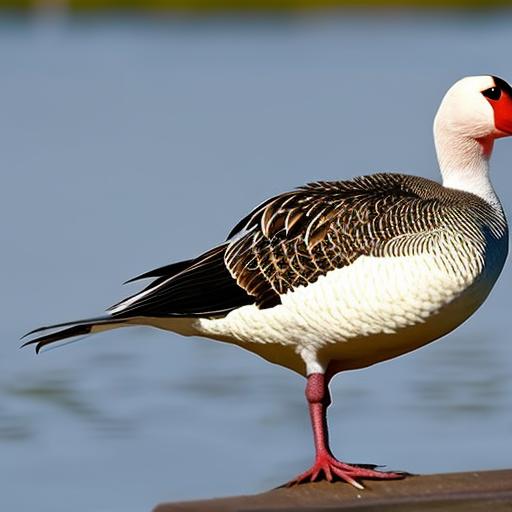Pet geese are known for their unique and sometimes challenging behavior. Understanding the behavior of pet geese is crucial for any owner to effectively care for and manage their geese. Geese are social animals and are known to form strong bonds with their owners and other animals. They are also highly territorial and can be protective of their space, especially during breeding season. Geese communicate through various vocalizations, body language, and behavior, and hissing is one of the ways they express their discomfort or aggression. It’s important for pet owners to recognize the signs of hissing and understand the reasons behind this behavior in order to address it effectively.
Geese may hiss as a warning signal to express their discomfort or to establish dominance. Hissing is a natural behavior for geese and is often used as a means of communication. It can be triggered by various factors such as feeling threatened, stressed, or anxious. Understanding the triggers for hissing behavior in pet geese can help owners address the underlying issues and provide a more comfortable and secure environment for their geese. By understanding the behavior of pet geese, owners can better anticipate and manage hissing behavior, ultimately fostering a healthier and more harmonious relationship with their geese.
Key Takeaways
- Pet geese are social animals and may exhibit hissing behavior when they feel threatened or anxious.
- Geese may hiss as a warning signal to communicate discomfort or to establish boundaries.
- When handling a hissing pet goose, it’s important to remain calm and avoid making sudden movements.
- Training techniques such as positive reinforcement and desensitization can help reduce hissing behavior in pet geese.
- Creating a comfortable environment with adequate space, shelter, and access to water can help minimize stress and hissing in pet geese.
- Seeking professional help from a veterinarian or animal behaviorist is important if a pet goose exhibits aggressive behavior.
- Patience and consistency are key in managing hissing behavior in pet geese, as it may take time for them to adjust to new training techniques and environments.
Reasons why pet geese hiss
There are several reasons why pet geese may hiss, and understanding these reasons is essential for effectively managing this behavior. One common reason for hissing in pet geese is fear or feeling threatened. Geese are naturally cautious animals and may hiss as a defensive response when they feel unsafe or vulnerable. This can occur when they encounter unfamiliar people, animals, or objects in their environment. Additionally, geese may hiss as a way to establish dominance or protect their territory. During breeding season, geese can become more territorial and may hiss to assert their dominance and protect their nesting area.
Another reason for hissing in pet geese is stress or anxiety. Changes in their environment, routine, or social dynamics can cause stress in geese, leading to hissing behavior. This can include factors such as moving to a new location, introducing new animals into their environment, or disruptions in their daily routine. Additionally, health issues or discomfort can also cause geese to hiss as a way of expressing their distress. By understanding the reasons behind hissing behavior in pet geese, owners can take proactive steps to address these issues and create a more comfortable and secure environment for their geese.
How to handle a hissing pet goose
Handling a hissing pet goose requires patience, understanding, and a calm approach. When a pet goose starts hissing, it’s important for owners to remain calm and avoid reacting with fear or aggression. Hissing is a natural behavior for geese, and it’s essential for owners to understand the underlying reasons behind this behavior before attempting to address it. Approaching a hissing pet goose with a calm and gentle demeanor can help de-escalate the situation and prevent further stress or aggression.
It’s important for owners to give their pet goose space and avoid crowding or cornering them when they are hissing. This can exacerbate their stress and lead to more aggressive behavior. Instead, owners should give their goose the opportunity to retreat to a safe and comfortable space where they can feel secure. Providing a quiet and peaceful environment can help reduce the likelihood of hissing behavior in pet geese. Additionally, owners should avoid making sudden movements or loud noises that can startle their goose and trigger hissing. By handling a hissing pet goose with patience and understanding, owners can help alleviate their goose’s stress and create a more harmonious relationship.
Training techniques for reducing hissing behavior
Training techniques can be effective in reducing hissing behavior in pet geese and fostering a more positive relationship between owners and their geese. Positive reinforcement training is one approach that can be used to encourage desirable behaviors in pet geese while discouraging hissing. This involves rewarding the goose with treats, praise, or attention when they exhibit calm and non-hissing behavior. By consistently rewarding positive behaviors, owners can help their geese associate calm behavior with positive outcomes.
Another training technique for reducing hissing behavior in pet geese is desensitization. This involves gradually exposing the goose to the triggers that cause them to hiss in a controlled and positive manner. For example, if a pet goose hisses when encountering unfamiliar people, owners can gradually introduce them to new individuals in a calm and non-threatening way. Over time, the goose can become desensitized to these triggers and learn to remain calm in these situations. Consistency is key when using training techniques to reduce hissing behavior in pet geese, and it’s important for owners to be patient and persistent in their efforts.
Creating a comfortable environment for pet geese
Creating a comfortable environment for pet geese is essential for promoting their well-being and reducing stress-related behaviors such as hissing. Geese thrive in environments that provide ample space for exercise, access to fresh water for swimming, and shelter from the elements. Owners should ensure that their geese have access to a secure and spacious outdoor area where they can graze, socialize, and engage in natural behaviors. Providing enrichment activities such as foraging opportunities, toys, and companionship with other geese can also help keep them mentally stimulated and content.
In addition to physical comfort, it’s important for owners to create a peaceful and predictable routine for their pet geese. Geese thrive on routine and can become stressed by sudden changes or disruptions in their environment. Establishing a consistent feeding schedule, providing regular opportunities for exercise and social interaction, and minimizing loud noises or disturbances can help create a calm and secure environment for pet geese. By creating a comfortable environment that meets their physical and emotional needs, owners can help reduce stress-related behaviors such as hissing in their pet geese.
Seeking professional help for aggressive pet geese

In some cases, aggressive behavior in pet geese may require professional intervention to ensure the safety of both the goose and its owners. If a pet goose exhibits persistent or escalating aggression, it’s important for owners to seek guidance from a veterinarian or animal behaviorist with experience in working with geese. A professional can conduct a thorough assessment of the goose’s behavior, health, and environment to identify any underlying issues contributing to the aggression.
Professional help may also be necessary if a pet goose’s aggression poses a risk to other animals or people in the household. A veterinarian or animal behaviorist can provide guidance on implementing management strategies to safely handle an aggressive goose and prevent potential injuries. They may also recommend specific training techniques or environmental modifications to address the underlying causes of aggression in the goose.
The importance of patience and consistency in managing hissing behavior
Managing hissing behavior in pet geese requires patience, consistency, and a long-term commitment from owners. It’s important for owners to understand that changing behavior takes time and that progress may be gradual. Consistency is key when implementing training techniques or environmental modifications to address hissing behavior in pet geese. By consistently reinforcing positive behaviors and providing a secure and comfortable environment, owners can help their geese feel more at ease and reduce stress-related behaviors such as hissing.
Patience is also essential when working with pet geese exhibiting hissing behavior. It’s important for owners to remain calm and composed when interacting with their geese, even when faced with challenging behaviors. Reacting with frustration or aggression can exacerbate stress in the goose and lead to further hissing or aggressive behavior. By approaching their pet goose with patience, understanding, and a calm demeanor, owners can help build trust and foster a more positive relationship with their goose over time.
In conclusion, understanding the behavior of pet geese is crucial for effectively managing hissing behavior and promoting a harmonious relationship between owners and their geese. By recognizing the reasons behind hissing behavior, implementing training techniques, creating a comfortable environment, seeking professional help when necessary, and demonstrating patience and consistency, owners can help reduce stress-related behaviors in their pet geese and provide them with a secure and enriching living environment.
If you’re dealing with pet geese that keep hissing, it’s important to understand their behavior and how to address it. In a related article on PoultryWizard, you can learn about the importance of insulating a chicken coop to provide a comfortable environment for your poultry. Understanding the needs of your birds and creating a suitable living space can help address behavioral issues like hissing in pet geese. Check out the article here for valuable insights on coop insulation and its impact on poultry behavior.
FAQs
What are some reasons why pet geese hiss?
Geese may hiss as a form of communication, to express fear or aggression, or to establish dominance within their social group.
How can pet owners address hissing behavior in geese?
Pet owners can address hissing behavior in geese by providing proper socialization, training, and a safe and comfortable environment. It is important to understand the reasons behind the hissing and address any underlying issues.
Are there any specific techniques to help reduce hissing in pet geese?
Some techniques to help reduce hissing in pet geese include positive reinforcement training, providing appropriate social interactions, and ensuring the geese feel secure and safe in their environment.
Can hissing behavior in pet geese be a sign of illness or discomfort?
Yes, hissing behavior in pet geese can be a sign of illness or discomfort. It is important for pet owners to monitor their geese for any other signs of illness or distress and seek veterinary care if necessary.
What are some common mistakes pet owners make when dealing with hissing geese?
Common mistakes pet owners make when dealing with hissing geese include misinterpreting the behavior, using punishment-based training methods, or not providing adequate socialization and environmental enrichment for the geese.
Meet Walter, the feathered-friend fanatic of Florida! Nestled in the sunshine state, Walter struts through life with his feathered companions, clucking his way to happiness. With a coop that’s fancier than a five-star hotel, he’s the Don Juan of the chicken world. When he’s not teaching his hens to do the cha-cha, you’ll find him in a heated debate with his prized rooster, Sir Clucks-a-Lot. Walter’s poultry passion is no yolk; he’s the sunny-side-up guy you never knew you needed in your flock of friends!







